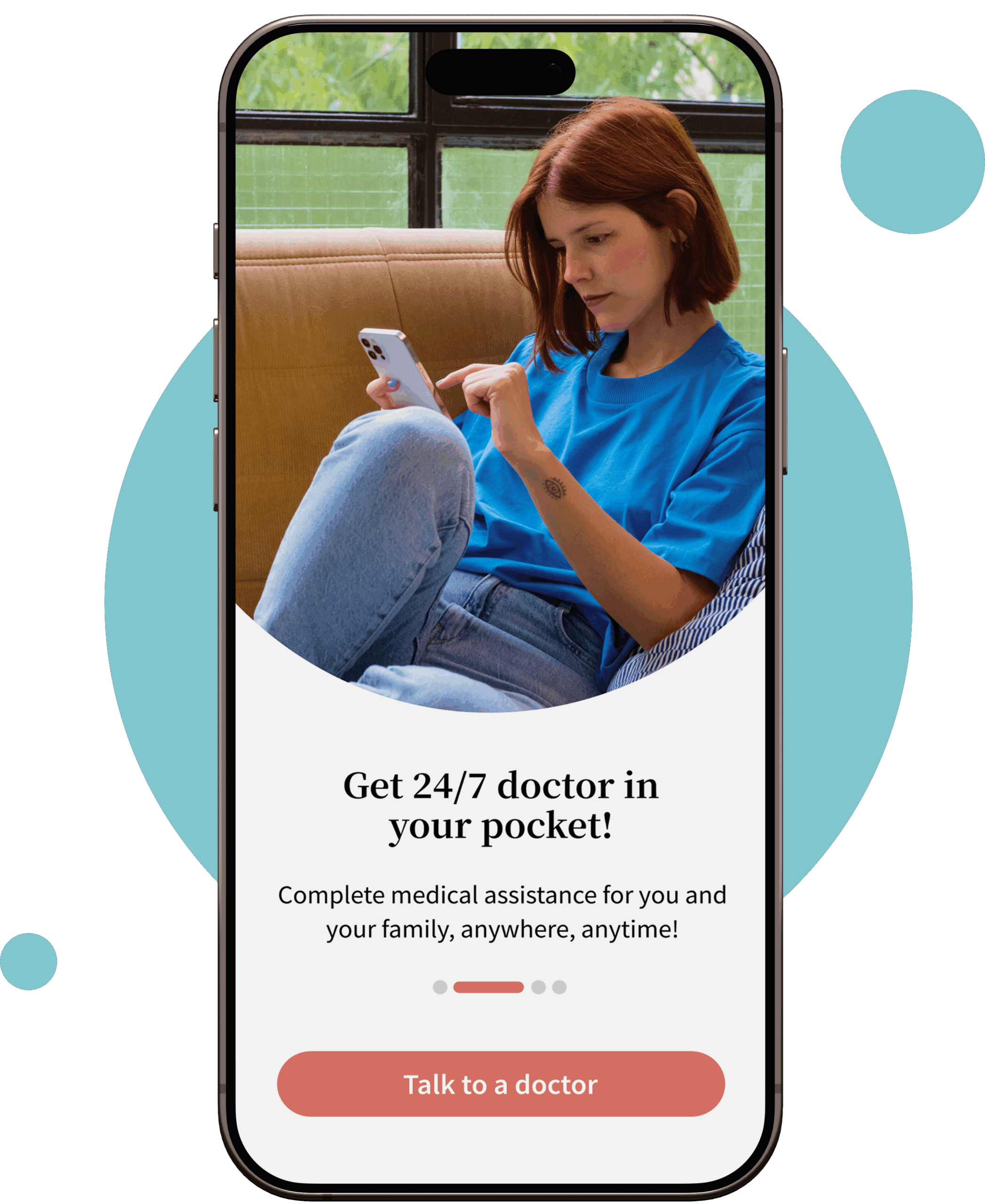
Get online treatment and prescription for acne
Acne can cause not only emotional pain but also physical. From permanent scarring, blemishes, and inflamed hair follicles to small bumps, it can be a daunting experience.
Timely treatment with antibiotics and prescription creams can stop it from getting worse. Get acne treatment from our virtual doctors 24/7 at Your Doctors Online.
What is acne?
Acne is a medical condition in which the hair follicles become clogged under the skin. After being clogged, the area gets inflamed and often gets foiled with a liquid discharge called pus formation on the skin, which often leads to outbreaks from different skin parts. It can be due to several reasons.
How do I know I have acne?
Acne can occur in all parts of the skin, either on the face, cheeks, forehead, shoulders, or back. You will know you have acne when you have:
- Outbreaks
- Pus formation in the bulging
- The redness and inflammation of the skin
- Irritation or itching of the skin
Acne is a symptom indicating several underlying conditions that lead to acne on the skin or different body parts.
What causes acne?
Some of the different causes that can lead to acne are:
- Excess oil production in the pores is called sebum.
- Clogged hair follicles are usually due to dead skin cells or oil production.
- Bacteria, e.g., Propionibacterium acnes, cause acne.
- Hormonal changes, especially during puberty, menstruation, or pregnancy.
- Some medications include corticosteroids and hormonal treatments.
- Genetics.
- Diet (high glycemic foods or dietary foods).
- High cortisol or Stress causes acne.
- Environmental factors like pollution and humidity can be the main causes.
- Certain skincare and cosmetic products.

What are the treatment options for acne?
Treatment options for acne depend on the cause of it. Your healthcare provider will prescribe medications according to the nature and severity of your medical condition.
Some of the most prescribed treatment options for acne include:
- Topical treatments like benzoyl peroxide, retinoids, salicylic acid
- Oral medications, including antibiotics, hormonal treatments, isotretinoin (accutane)
- Both topical and oral medications in combination.
- Healthcare providers often recommend light therapy (photodynamic or blue light therapy).
- Extraction of comedones (blackheads and whiteheads).
- Laser therapy can also be prescribed depending on the underlying medical condition.
- Lifestyle changes (such as proper skincare routine, diet modifications, stress management)
- Home remedies (such as tea tree oil, aloe vera, honey)
Acne medication we prescribe
keratolytic agents
Learn MoreAntibiotic
Learn Moreretinoids
Learn MoreHow can you prevent acne?
Acne can be prevented in several ways, including:
- Maintaining a consistent skincare routine will help eliminate clogged pores.
- Keep your face and skin clean by washing it twice daily and pat dry.
- Use non-comedogenic skincare products.
- Staying hydrated by drinking plenty of water will help regulate the body’s normal metabolism and electrolyte balance.
- Follow a balanced diet rich in fruits and vegetables to stay full of nutrients and lead to healthy skin.
- Get regular exercise to promote healthy circulation. If not rigorous exercise, regular stretching would help maintain blood circulation.
- Manage stress levels through relaxation techniques.
- Avoid excessive sun exposure and use sunscreen.
NOTE: In case of an underlying condition like a hormonal imbalance causing acne, it can not be prevented. Instead, it needs proper diagnosis and medication.
How to connect with doctor for acne
Connect with a health care professional online in 3 easy steps.
1
Describe your issue
Download our app, register and tell us about your medical issue to get started.
- Acne
- Anemia
- STD
- UTI
- Skin
- Covid
2
Chat with a doctor
Connect with a board-certified doctor. You can chat, send pictures and videos.
Hey Dr. Jessica, I have pus-filled pimples on my face. I have tried everything, can you help me?
3
Get online prescription
Our online doctors can help you with your medical issues and give you prescriptions.
Prescription
- Benzoyl peroxide 2.5% gel, apply once daily for 8 weeks.
- Clindamycin cream, apply twice daily for 8 weeks
Send Prescription
FAQS about acne treatment online
What is the best acne spot treatment?
Some of the best acne treatments include: Salicylic acid, benzoyl peroxide, sulfur, or topical retinoids.
What are the types of acne scars?
Acne scars are classified as atrophic scars, hypertrophic and keloid scars
Can I get an acne prescription at Your Doctors Online?
Yes, connecting with an online dermatologist couldn’t be easier. You can download our app, and connect with one of our reliable doctors and
Why is my acne getting worse with treatment?
If your acne worsens with the treatment, it means there is rapid destruction of the bacteria causing acne that leads to inflammation or breakouts. It's good to consult your healthcare provider as soon as possible to get the proper diagnosis. Usually, it doesn't happen, and the acne dries after the treatment starts.
When to see a doctor for acne?
See a doctor for acne if you experience scars getting darker, pimples under the skin getting bigger (cysts), acne bleeding, or have a family history of acne. In these conditions, you need a proper consultation and personalized treatment plan to control your acne immediately with medications and management.
What is the best treatment for hormonal acne?
The best treatment for hormonal acne includes Oral contraceptives, especially for women, or medication, including spironolactone, oral antibiotics, topical retinoids, and Isotretinoin (Accutane) for severe cases.
What is the new FDA-approved treatment for acne?
The recent FDA-approved acne treatment is clascoterone 1% cream, available in the United States and Canada. This formulation is named under the brand name Winlevi, which is a topical Androgen receptor inhibitor designed to treat hormonal acne.
What pills clear up acne fast?
The fastest treatment for acne is oral medications, including tetracycline or macrolide, as per your age and condition. Your doctor can better prescribe you medication upon consultation as per your symptoms.
Is it worth it to take Accutane?
Accutane is good for most people as it helps reduce the chances of remission of acne. However, it can affect one in five people, causing adverse side effects. Therefore, it is better to consult a doctor before trying anything for acne.
Why isn't my acne clearing up?
It may happen if your medication, diet, or lifestyle triggers the acne. Get a follow-up consultation from your provider. Sometimes, resistant bacteria are not killed by the antibiotics you are prescribed. See a doctor without an appointment or wait times within minutes at Your Doctors Online.
How do I know if my acne is bacterial or hormonal?
If your acne is bacterial, it will appear more on your T-zone, including your chin, nose, and forehead. In the case of hormonal acne, it appears more frequently on the lower face and jawline. It is better to consult a doctor for a proper diagnosis of your acne cause.
Related Blog Articles

15 Tips for Healthy Skin Care Just for Women
Every woman who seems to have the perfect skin has religiously followed the best daily

What is the best prescription cream for Rosacea?
Overview Let’s face it: a cheek tint may be in vogue, but persistent facial redness

What is pimple on scrotum and how do you treat it?
Overview Pimples are not a pleasant surprise anywhere on the body, but it is quite
Get started today
Talk to online doctors now and get medical advice, online prescriptions, and referrals within minutes. On-demand healthcare services at your fingertips.



